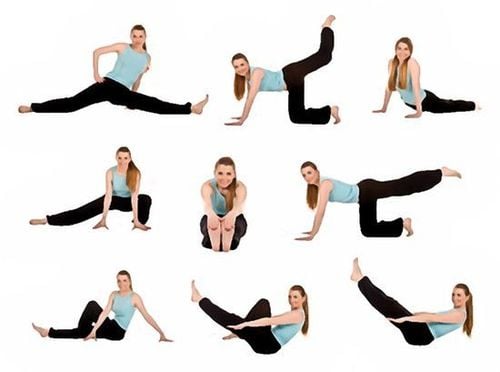This is an automatically translated article.
Practicing yoga offers a much-needed opportunity to connect with your unborn baby and with your body throughout pregnancy. Whether you're new to yoga or an experienced practitioner, you can enjoy the many benefits of yoga during pregnancy. In this article are the things you need to know to practice Yoga in the last months before giving birth.1. What is yoga in the last months before giving birth?
When you're pregnant, you want to stay in shape and do what's best for you and your baby, and prenatal yoga is a great way to do both. Many people may not know, but experts encourage mothers to do prenatal exercises for many reasons. Prenatal exercise helps ease uncomfortable pregnancy symptoms like constipation, back pain, bloating, swelling, and fatigue. And according to the American Association of Obstetricians and Gynecologists, staying active also helps moms mentally, boost their energy, improve their mood and ability to sleep (which can be complicated). than when they were pregnant). But prenatal yoga may just be the ideal exercise for pregnant women. Here's what you need to know before starting your prenatal yoga routine.What is prenatal yoga? Yoga is a form of exercise and meditation in which breathing and specific body positions are used to help connect mind and body. And prenatal yoga focuses on poses specifically designed for pregnant women's bodies.
What is the difference between prenatal yoga and regular yoga? Common yoga poses – such as the feet apart – can put undue stress on your joints and pelvic area during pregnancy. As the baby grows, the weight on the mother's bladder and pelvis also increases. Pregnancy hormones also loosen the mother's ligaments, making bone problems (especially in the pubic bone) a source of discomfort. In addition to correcting pregnancy positions, prenatal yoga emphasizes breathing, stretching, and strengthening movements that help prepare your body for labor.
Mothers who have never practiced yoga should ever do prenatal yoga Yes! You don't have to be a yogi (a term used to refer to people who practice yoga) before conception to be able to practice prenatal yoga. As long as your doctor recommends staying physically active during pregnancy, yoga is an ideal activity for all moms-to-be: Prenatal yoga is a gentle and well-designed exercise pregnancy-specific, which means it helps prepare moms mentally for childbirth (and beyond). But remember to talk to your doctor before starting any new exercise during pregnancy.

Miễn là được bác sĩ đưa ra khuyến cáo duy trì hoạt động thể chất trong khi mang thai, yoga là một hoạt động lý tưởng cho tất cả các bà mẹ trong tương lai
An introduction. Your yoga teacher will want to know your name, the length of your pregnancy, any aches and pains you're experiencing, and the body parts or poses you want to practice. You'll likely get a chance to mingle with other moms during this time: Most yoga studios encourage their students to chat before and after class, many asking moms to share a a little bit about their pregnancy experience - worries, hopes, dreams with the group before class starts. A short period of relaxation. Like regular vinyasa classes, the session usually begins with a brief period of rest and inward focus (a practice you may find helpful during labor). Brief launch. Mothers will be instructed to slowly move their bodies so that their muscles and joints are ready for the session. A standing vinyasa flow. This will incorporate movements that tone the abs and pelvic floor muscles, followed by a hip and rib cage opening, while emphasizing deep, diaphragmatic breathing (not shallow "hee-hee-hoo"). -hoo" is combined with Lamaze). In general, many of the poses you adopt are similar to those performed in a regular vinyasa class, they will only be modified for your safety. Gently stretch. The teacher will guide mothers to do a few stretches to stretch and relax the muscles. This will make moms feel good! A modification of savasana. After all the hard work of a mother, teachers will instruct mothers to relax in "savasana" where they will lie on their backs with their eyes closed. The position will be modified depending on the length of pregnancy: During the second trimester, mothers lie on their backs with a pad to raise the upper body to a 45-degree angle, while in the third trimester, they lie down with a pad and blanket for support. This pose is recommended to stay for about 6-7 minutes: It's a peaceful pose to bring about a feeling of complete relaxation. And it's really cool!
2. Practicing Yoga in the last months before giving birth: What you need to know
If you're pregnant and looking for ways to relax or simply stay in shape, you may want to consider prenatal yoga. But did you know that prenatal yoga can also help prepare you for labor and strengthen your unborn baby? Before you start practicing prenatal yoga, learn the benefits it can offer, what a typical yoga class entails, and tips to help keep it safe.What are the benefits of prenatal yoga? Like other types of classes for moms-to-be, prenatal yoga is a varied approach to exercise that encourages stretching, mental focus, and focused breathing. Research shows that prenatal yoga is a safe practice and can have many benefits for pregnant women and their unborn babies. Prenatal yoga can:
Improve sleep Reduce stress and anxiety Increase muscle strength, flexibility and endurance needed for childbirth Reduce lower back pain, nausea, headaches and difficulty breathing (typical symptoms experienced by mothers during pregnancy). Prenatal yoga can also help you meet and bond with other pregnant women and prepare for the stresses of motherhood.

Nghiên cứu cho thấy rằng yoga trước khi sinh là phương pháp tập luyện an toàn và có thể mang lại nhiều lợi ích cho phụ nữ mang thai và thai nhi
Breathing. Mothers will be encouraged to focus on breathing in and out slowly and deeply through the nose. Prenatal yoga breathing techniques can help mothers reduce or manage shortness of breath during pregnancy and through contractions during labor. Gently stretch. Mothers will be encouraged to gently move different areas of the body, such as the neck and arms, through their full range of motion. Postures. While standing, sitting or lying on the ground, moms will gently move your body into different positions to develop your strength, flexibility and balance. Props - such as blankets, cushions and belts - can be used for support and comfort. Cool down and relax. At the end of each prenatal yoga class, mothers relax their muscles and restore resting heart and breathing rates. They may be encouraged to listen to their own breathing, pay attention to feelings, thoughts, and emotions, or repeat a mantra or word to bring about a state of self-awareness and inner calm. . What yoga exercises are not recommended for pregnant women? There are many different styles of yoga - some are more difficult than others. Prenatal yoga, hatha yoga, and restorative yoga are the best options for pregnant women. Yoga teachers will provide mothers with information on what yoga should and should not be done during pregnancy.
Avoid doing hot yoga exercises, which are exercises that perform vigorous poses in a room that is heated to a higher temperature. For example, in the Bikram form of Hot Yoga, the room is heated to about 40 degrees Celsius and has a humidity of 40 percent. Hot yoga can raise mothers' body temperatures too much, causing a condition known as hyperthermia.

Mẹ bầu nên tránh tập các bài tập yoga nóng, là những bài tập thực hiện các tư thế mạnh mẽ trong phòng được làm nóng ở nhiệt độ cao hơn
Talk to doctors or professionals before starting a prenatal yoga program. Mothers may be warned against prenatal yoga if they are at high risk for preterm labor or have certain medical conditions, such as metabolic cardiovascular disease or back problems. Set realistic goals. For most pregnant women, at least 30 minutes of moderate physical activity is recommended on at least five days of the week. However, shorter or less frequent exercises can still help them stay in shape and prepare for labor. Always keep your body cool and hydrated. Do prenatal yoga in a well-ventilated room to avoid overheating. Drink plenty of water to stay hydrated. Avoid certain postures. When performing poses that bend the hips - not the back - to maintain the normal curvature of the spine. Avoid lying on your stomach or back, doing deep forward or back bends, or doing twists that put pressure on your abdomen. Mothers can modify twists to move only the upper back, shoulders, and rib cage. As your due date approaches, use props in poses to accommodate changes in your body's center of gravity. If you wonder if a pose is safe, ask your class teacher for guidance. Do not abuse yoga. Pay attention to your body and sensations. Start slowly and avoid positions that are beyond your body's experience or comfort. Only stretch as much as you could have before you got pregnant. If mothers experience pain or other danger signs - such as vaginal bleeding, decreased fetal movement or contractions - during prenatal yoga, stop and get in touch. with a doctor or specialist

Lưu ý chỉ kéo căng đến mức bạn có thể có trước khi mang thai
Today, pregnant mothers are encouraged to exercise or be physically active to reduce uncomfortable symptoms during pregnancy as well as mentally and physically stable for women. mothers to best prepare for labor. It is also for these reasons that pre-yoga was born. Prenatal yoga includes gentle exercises, based on helping mothers work to stretch the muscles involved in labor. In addition, prenatal yoga also focuses on mental stability and breathing control during pregnancy.
Please dial HOTLINE for more information or register for an appointment HERE. Download MyVinmec app to make appointments faster and to manage your bookings easily.
Reference source: whattoexpect.com, mayoclinic.org












